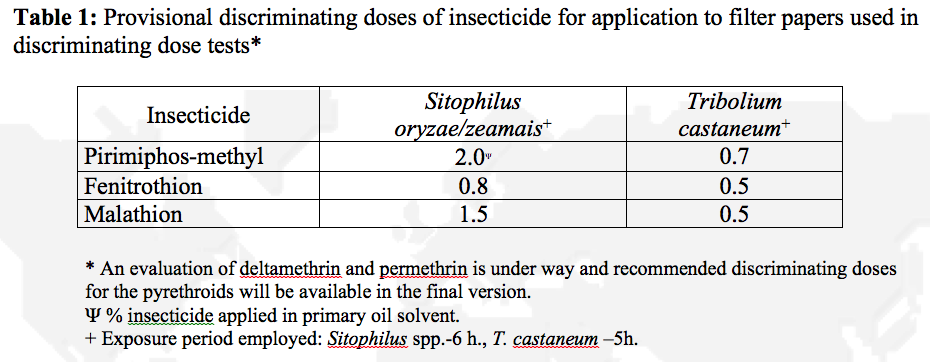Method
Beetles are collected by: (1) sieving the infested commodity, (2) brushing the floor, wall or surface of bags, (3) using a pooter/aspirator. If sufficient insects are available, these should be separated from the commodity prior to testing and placed in vials in groups of 40, progressively placing a maximum of 10 insects in each vial and repeating the procedure until the required number is reached. This helps to minimize batch variation.
Hold insects without food for 1 h at 25-27°C and at approximately 70 % R.H. before assigning batches randomly to treatments.
Select appropriate pre-treated filter papers according to the species under investigation and place on a firm clean flat surface (e.g. glass). Place plastic rings centrally on top of papers. See Table 1 for proposed discriminating doses. Where insects to be tested include Sitophilus spp. the inside surface of rings must be painted with a thin film of Fluon to prevent escape. It may also be desirable to treat the base of the rings to minimize insecticide contamination.
Place insects on test papers inside rings, and hold insects under the conditions described above, avoiding direct sunlight. Covers may be necessary to retain some species which tend to fly at 25°C.
After the recommended exposure period (according to species), examine insects and record number knocked down (defined as inability to stand and walk) or dead. A gentle push with forceps is usually sufficient to categorize individuals.
From the results of observations in a test, insects are classed as fully susceptible (i.e. not resistant), where complete knockdown occurs, partially resistant when there is less than complete knockdown, or wholly resistant when no knockdown takes place. Where partial or no knockdown takes place, further investigation may be necessary using a graded range of insecticide concentrations in order to determine the degree of resistance. Advice concerning these tests should be sought from local government specialists but, failing this, advice may be obtained from the Natural Resources Institute (NRI), Chatham Maritime, Chatham, Kent, England, ME4 4TB, UK).
Precautions & Notes
- Enquiries about the availability of insecticide-impregnated filter papers should be addressed to NRI. Only freshly treated papers should be used. Papers more than 6 months old should be discarded and new samples obtained from NRI.
- If there are insufficient insects available, or further tests are desirable, they may be bred in the laboratory and tested in the following F1 generation. The medium in which the sample beetles were originally collected may contain sufficient eggs for progeny. Details of the life cycles and expected times of emergence of key species are given in FAO method no. 15.
- It is highly desirable that all data concerning the infestation from which the insects were collected should be recorded, including details of the infested food, type of warehouse, location and previous insecticide usage.
- Since plastic tends to absorb insecticide more readily than does glass, it is essential, that plastic rings are decontaminated thoroughly after each test by overnight soaking in several changes of water and detergent.
- Care should be taken not to extrapolate the results of these findings to other populations or locations in the area, unless there is substantial supporting data.
